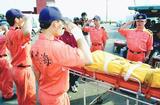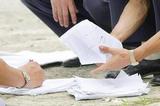
Posted on 05/27/2002 11:45:29 AM PDT by twntaipan
| Coast Guard members salute the body of a China Airlines crash victim at Penghu's Makung Airport yesterday. PHOTO: GEORGE TSORNG, TAIPEI TIMES |
By Chiu Yu-tzu and Patrick Kearns
STAFF REPORTERS
A Chinese missile or fuel-tank explosion similar to what brought down TWA Flight 800 off the coast of New York in 1996 were among the theories put forth by aviation experts and other sources yesterday to explain Saturday's China Airlines crash.
Kay Yong (¦¥³Í), head of the Aviation Safety Council, said yesterday that flight CI611 experienced an "inflight breakup" at more than 9,100m -- crumbling into four large pieces before falling into the ocean.
The suddenness of the flight's demise -- the plane's pilots reportedly did not radio for help -- had some experts focusing on the possibility that an explosion might have brought the Boeing 747-200 down.
 |
| Investigators make numbered tags with pieces of cloth to mark the bodies retrieved from the sea. PHOTO: CHANG CHIA-MING, TAIPEI TIMES |
According to one anonymous source connected with a Taiwanese think tank, the possibility that a Chinese missile downed the plane can't be ruled out. The People's Liberation Army is currently practicing drills along China's southern coast, the source noted.
Indeed, it wouldn't be the first time that a military misfire has downed a passenger jet. In October, a Russian passenger jet crashed into the Black Sea after being unintentionally hit by an S-200 missile during Ukrainian air defense exercises.
According to the source, China's inventory of military hardware includes a missile known as the S-300 PMU, or "SA-10 grumble." The PLA demonstrated the missile in 1996 just before Taiwan's 1996 presidential election.
But the Hong Kong-based Wen Wei Boa (¤å¶×³ø) yesterday quoted a source in Beijing as saying that no missile tests were performed on Saturday.
The S-300 PMU has a range of 120km, a maximum speed of Mach 7 and would be difficult to be tracked by radar, the anonymous source said.
According to the US Federation of American Scientists, China imported S-300 missiles from Russia in the early 1990s and they are deployed around Beijing. But there is one battery of fixed, long-range S-300s in Zhangzhou in Fujian Province, the source said.
"When an airplane flying at 9,100m collides with any outside force -- say a 1,600kg S-300 missile with a dummy warhead -- the loss of pressure inside the cabin could cause the situation to spin out of control," the source said.
Sudden depressurization inside the cabin would have knocked out the pilots, preventing them from sending a Mayday.
Other signs suggesting an accidental Chinese missile strike were Beijing's unusual friendliness in expressing concern over the tragedy and its offer to help search for survivors just hours after the accident; reports from pro-China media that were quick to downplay any connection between China's military exercises and the accident; and Premier Yu Shyi-kun taking command of search-and-rescue efforts in Penghu. Never before has the premier been placed in charge of an air crash accident, sources said.
TWA FLIGHT 800
One veteran pilot who contacted the Taipei Times yesterday said Saturday's crash bore striking similarities to the crash of TWA Flight 800 off the coast of Long Island, New York in 1996.
The pilot sought to keep his identity private for fear of reprisals from the Civil Aeronautics Administration (CAA).
"Talking to several other pilots after we heard about the crash, we all agreed it suffered the same fate as TWA Flight 800 -- a center fuel-tank explosion," the pilot said.
After nearly four years of investigation, US inspectors said an explosion of vapors inside a fuel tank caused TWA Flight 800 to plunge into the ocean -- in a safety problem that may involve thousands of commercial aircraft built by a number of different manufacturers.
The Taiwan-based pilot alleged that China Airlines knew its 747-200 was vulnerable to the safety problem surrounding the troublesome fuel tank but failed to eliminate the risk.
Government officials yesterday ordered China Airlines to ground its four remaining Boeing 747-200s, which are used for cargo delivery.
As many airplanes do, TWA Flight 800 took off with just 50 to 100 gallons of fuel in its center tank. The procedure is used on short-haul flights to cut the overall weight of the plane and thus save on expensive jet fuel costs.
In the case of TWA 800, experts said fumes inside the tank were heated to above the temperature at which they become explosive -- dooming the 747. What's not known is what ignited the blast.
China Airlines flight CI611 also took off with its center tank nearly empty -- a procedure that Boeing recommended be discontinued after the US Federal Aviation Administration (FAA) in 1998 said fuel pumps on older model 747 planes were a possible source of faulty wiring that could have ignited the TWA blast.
"The FAA today issued an Airworthiness Directive prohibiting dry operation of the center wing tank override/jettison pumps ..." on applicable 747 airplanes, Boeing said in the statement to all owners of the planes.
The pilot said China Airlines continued the risky practice "because here in Taiwan everything is about money."
Warnings from boeing
China Airlines vice president of flight safety, Samson Yeh (¸¤S«C), confirmed that the airline had received notification from Boeing not to run the center tank dry, but that they made their own safety modifications to eliminate any potential point of ignition.
"At the time ... I remember we changed the procedure. In terms of empty fuel tanks we were not supposed to use the fuel pumps [when we flew with dry tanks], otherwise you will overheat it. I believe [the maintenance department] also put some insulation on the wiring, to isolate [potential sparks]," Yeh said.
Yeh did concede that while an overheated fuel tank was "one of the possibilities" behind the sudden mid-air break up, "this case is different from [TWA 800] because that one was caused by the center fuel tank overheating, whereas this one was a sudden explosion -- which means it's totally different."
Another option for planes designated specifically for short-haul flights is the removal of the center tank and its pump -- a costly and time-consuming process, according to the pilot.
A 16-year veteran for an international carrier, but based in Taiwan, the anonymous pilot said many cabin crews know China airlines' last remaining passenger 747-200 was flying with the potential risk, but that reporting the issue to civil authorities -- charged with overseeing the two national carriers -- could result in the loss of their jobs.
No Taiwan-based pilots want to say anything negative about "the airline industry in Taiwan. They [officials] are very vindictive. We all have to do our PC," he said, referring to a "precision check," a test required by the CAA every six months that allows pilots to stay in the air. "If we said anything they'd fail us for sure."
Another similarity between Saturday's crash and the crash of TWA Flight 800 is that in the latter, many speculated that a missile brought the plane down.
But crash investigators later concluded that it wasn't a missile or a bomb blast that downed the plane.
"High-energy explosions leave distinctive damage signatures such as severe pitting, cratering, hot gas washing and petaling," said Bernard Loeb, director of the US National Transportation Safety Bureau last year. "No such damage was found on any portion of the recovered airplane structure."
The physical evidence "leads to the inescapable conclusion that the cause of the in-flight breakup of TWA Flight 800 was a fuel-air explosion inside the center wing tank," Loeb said.
If this B-747 broke apart, it was struck by something.Maybe This
Disclaimer: Opinions posted on Free Republic are those of the individual posters and do not necessarily represent the opinion of Free Republic or its management. All materials posted herein are protected by copyright law and the exemption for fair use of copyrighted works.